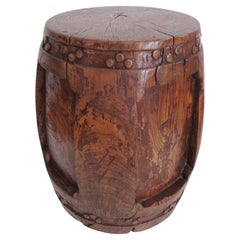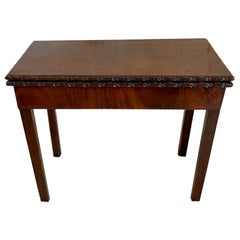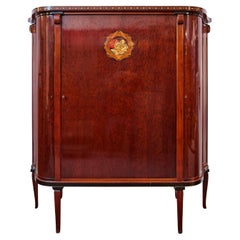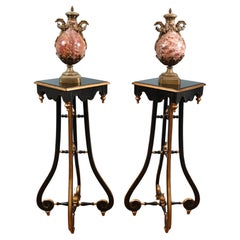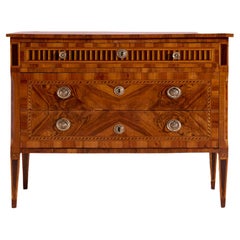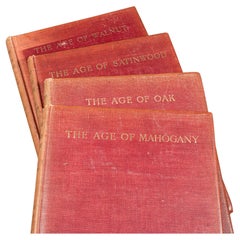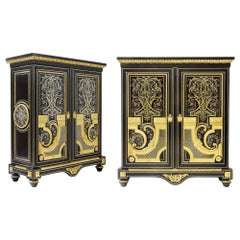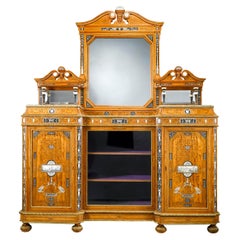History Of Antique Furniture
Early 20th Century British Art Deco History Of Antique Furniture
Paper
Early 19th Century Chinese History Of Antique Furniture
Wood, Elm
18th Century English George III History Of Antique Furniture
Other
1920s French Art Deco History Of Antique Furniture
Wood
1850s History Of Antique Furniture
Wood
Late 18th Century Italian Louis XVI History Of Antique Furniture
Walnut
Early 20th Century British Edwardian History Of Antique Furniture
Paper
Late 19th Century French Louis XIV History Of Antique Furniture
Marble, Brass, Ormolu, Bronze
19th Century English Neoclassical History Of Antique Furniture
Marble, Bronze
18th Century and Earlier French Renaissance History Of Antique Furniture
Oak, Walnut
1920s Italian Neoclassical Revival History Of Antique Furniture
Walnut
Late 19th Century American Victorian History Of Antique Furniture
Walnut
Mid-18th Century German Baroque History Of Antique Furniture
Brass
19th Century Dutch Other History Of Antique Furniture
Wood
Early 20th Century History Of Antique Furniture
Paper
Early 20th Century British Country History Of Antique Furniture
Brass
Early 19th Century British History Of Antique Furniture
Paper
Early 1900s European History Of Antique Furniture
Paper
Early 1900s British History Of Antique Furniture
Paper
Late 19th Century Japanese Meiji History Of Antique Furniture
Cedar
Early 20th Century European History Of Antique Furniture
Paper
17th Century French Aubusson History Of Antique Furniture
Wool, Silk
17th Century Belgian Other History Of Antique Furniture
Wool, Silk
19th Century French History Of Antique Furniture
Marble, Ormolu
1890s French Louis XVI History Of Antique Furniture
Marble, Bronze
1780s German Baroque History Of Antique Furniture
Walnut
Late 19th Century French Belle Époque History Of Antique Furniture
Marble, Bronze, Ormolu
1830s American Early Victorian History Of Antique Furniture
Leather, Fabric, Paper
18th Century History Of Antique Furniture
Paper
15th Century and Earlier British History Of Antique Furniture
Natural Fiber
19th Century Spanish Arts and Crafts History Of Antique Furniture
Wood, Walnut
1790s History Of Antique Furniture
Paper
1880s American History Of Antique Furniture
Paper
1840s English Folk Art History Of Antique Furniture
Paper
Late 19th Century French History Of Antique Furniture
Paper
Early 17th Century Dutch History Of Antique Furniture
Paper
Early 17th Century Dutch History Of Antique Furniture
Paper
Early 20th Century European History Of Antique Furniture
Paper
Mid-19th Century British History Of Antique Furniture
Paper
1840s British History Of Antique Furniture
Paper
1840s British History Of Antique Furniture
Leather
Early 17th Century Dutch History Of Antique Furniture
Paper
Early 17th Century Dutch History Of Antique Furniture
Paper
19th Century History Of Antique Furniture
Brass
19th Century French Other History Of Antique Furniture
Leather, Paper
Early 1800s American History Of Antique Furniture
Leather
19th Century History Of Antique Furniture
Glass, Wood, Paper
1830s History Of Antique Furniture
Paper
1890s History Of Antique Furniture
Paper
Late 19th Century English History Of Antique Furniture
Paper
Early 1900s History Of Antique Furniture
Paper
Late 18th Century English History Of Antique Furniture
Paper
Mid-19th Century French Louis Philippe History Of Antique Furniture
Bronze
Late 19th Century German History Of Antique Furniture
Paper
Late 19th Century History Of Antique Furniture
Paper
Early 19th Century English History Of Antique Furniture
Gold Leaf
1830s History Of Antique Furniture
Paper
- 1
- ...
History Of Antique Furniture For Sale on 1stDibs
How Much is a History Of Antique Furniture?
- 1stDibs ExpertMay 14, 2024The history of Martinsville furniture starts with the founding of the company in Martinsville, Virginia, in 1906 by Ancil Witten and Charles Keesee, a pair of former tobacco farmers. They launched their business with $30,000 in capital and began to manufacture bedroom furniture under the name American Furniture Company. In the 1920s, American Furniture Company expanded its offerings from bedroom furnishings with a range of dining room sets. By the 1950s, the company’s name had been changed to American of Martinsville, and it had gained a reputation for exquisite craftsmanship as well as a variety of furniture styles. Inspired by designers like George Nakashima and Paul László, the brand innovated with wood. Merton Gershun was one of the company's most prolific designers, and he was responsible for some of its most successful modern furniture lines using the richer, darker woods that would become emblematic of mid-century furniture. Gershun's most popular line was Dania, with its sleek walnut credenzas fitted with stylish brass accents and large drawers. Today, American of Martinsville specializes in furniture for the healthcare and hospitality industries. Find a variety of American of Martinsville furniture on 1stDibs.
- 1stDibs ExpertOctober 24, 2024The history of Kartell furniture begins with Italian chemical engineer Giulio Castelli and his wife, Anna Ferrieri. They founded the company in 1949 as an industrial design firm, producing items like ski racks for automobiles and laboratory equipment designed to replace breakable glass with sturdy plastic. They launched a housewares division of Kartell in 1953, making lighting fixtures, kitchen tools and accessories from colorful molded plastic. The affordability and infinite range of styles and hues won devotees of Kartell’s ingenious designs for juicers, dustpans and dish racks. Kartell designer Gino Colombini was responsible for many of these early products, including the KS 1146 Bucket, which won the Compasso d’Oro prize in 1955. Buoyed by its success in the home goods market, Kartell introduced its Habitat division in 1963. In 1972, Kartell achieved international recognition for its innovative work when a landmark exhibition curated by Emilio Ambasz called “Italy: The New Domestic Landscape” opened at New York’s Museum of Modern Art. In 1988, Castelli and Ferrieri sold Kartell to Claudio Luti, their son-in-law, who has expanded the company’s roster of designers. Shop a collection of Kartell furniture on 1stDibs.
- Is antique furniture in style?1 Answer1stDibs ExpertApril 22, 2024Yes, antique furniture is in style. Many people appreciate the beauty and handcrafted character of antique furniture and love the idea of owning pieces with a rich history. Remember that style preferences are nothing if not fluid, meaning what's in one year may not be the next. So, in choosing the furniture you're planning to live with, you should pay less attention to interior design fads than to what speaks to you. That way, you can select pieces that will add long-term character to your home. On 1stDibs, find a large collection of antique furniture.
- 1stDibs ExpertMay 30, 2024To identify your antique furniture, look for an engraving, tag, label or other marking that indicates who produced it. You may find it on the bottom or back of your furniture or inside a drawer or cabinet. Once you have located the marking, you can snap a photo of it and use a reverse image search to try and identify the maker. Or, you can type a description of the mark into a search engine. Alternatively, you can use the services of a certified appraiser or antiques dealer to get assistance with identification. On 1stDibs, shop a large selection of antique furniture.
- What makes furniture an antique?1 Answer1stDibs ExpertAugust 15, 2019
A piece of furniture is considered an antique if it is at least 100 years old.
- 1stDibs ExpertMay 14, 2024Many antique furniture brands are popular. While trends in collecting do vary over time, some makers consistently remain highly sought after. Among them are J. & J.W. Meeks, John Henry Belter, R. J. Horner and Co., Stickley Furniture, George Hepplewhite, Josef Dannhauser, Thomas Chippendale and Thomas Sheridan. On 1stDibs, shop a variety of antique furniture.
- 1stDibs ExpertApril 5, 2024To know if your furniture is antique, look for labels and markings that indicate the maker. From there, you can use trusted online resources to determine when they were active and examine images to try to estimate the age of your piece. Furniture produced 100 years ago or more is antique. You can also have your furniture assessed by an appraiser or antiques dealer to learn about its age. On 1stDibs, explore a large collection of antique furniture.
- 1stDibs ExpertFebruary 22, 2021Antique furniture can be worth quite a lot, particularly if it is in good quality. The rarer the piece, the higher the value.
- 1stDibs ExpertFebruary 13, 2024Whether antique furniture is making a comeback is a matter of opinion. Many people would argue that antique furniture never faded from fashion, as there have always been individuals who love the idea of owning pieces that have history. Some of the most popular styles for antique furniture include Art Deco, Arts and Crafts, Renaissance Revival, Elizabethan, Gothic Revival, Victorian and Chippendale. Find a large collection of antique furniture from some of the world's top dealers on 1stDibs.
- 1stDibs ExpertFebruary 1, 2024To date antique furniture from the UK, first look for identifying markings on the piece. You can then use trusted online resources to determine when the maker was active. From there, you may be able to estimate the year of production by looking at images of other furniture the maker produced. An expert appraiser or antiques dealer can also aid you in the dating process. Find a large selection of antique furniture on 1stDibs.
- 1stDibs ExpertFebruary 22, 2021There are a number of factors that can indicate if your antique furniture is valuable. When determining the value of antique furniture, consider its rarity. Additionally, it is important to determine the quality and condition of vintage furniture. If unsure of the value of your vintage furniture, have it appraised.
- 1stDibs ExpertNovember 4, 2024To identify antique Chinese furniture, look carefully at its details. Chinese craftsmen often built furniture using mortise and tenon joinery, eliminating the need for nails and screws. If you see this type of hardware, your piece is likely not at least 100 years old, especially if the hardware still looks new and shiny. Since antique furniture was handmade, you will normally see slight imperfections, such as tool marks or slight variations in carvings. Pieces that appear completely uniform and pristine are less often genuine antiques.
When present, maker's marks can also be helpful. Research the marks to learn more about when the maker was active and producing pieces like yours. Alternatively, you can have a certified appraiser or experienced antique dealer evaluate your furniture for you.
Shop an assortment of antique Chinese furniture. - 1stDibs ExpertOctober 5, 2021The best finish for antique furniture is a matter of liking. But film finish is recommended by experts as it leaves a thick coat of film on the wood surface which protects wood from water and scratches. Shellac or varnish and water base are commonly used film finishes. Find an exquisite collection of antique, new and vintage furniture on 1stDibs
 PAGODA REDOctober 7, 2020
PAGODA REDOctober 7, 2020To determine the age of a Chinese furniture piece, look carefully at the joinery and finish. Natural expansion and contraction of the wood over time will cause a joint to protrude or retract, distorting a once-seamless fit. Antique lacquer finishes become crackled and worn over time. Areas of exposed wood, such as the underside of a table, the footrest of a chair, or the back of a cabinet should appear raw and dry compared to the finished surface. With use, the legs of tables and chairs become weathered near the bottom from precipitation and use.
- 1stDibs ExpertAugust 29, 2024To tell how old your antique furniture is, research the maker using trusted online resources. You may find that the furniture maker was active for only a short period, giving you the ability to roughly estimate its age. For manufacturers and designers with a long history of production, consider the style of your furniture and look for images of similar pieces published online. Because it may be difficult to date furniture on your own, consider consulting a certified appraiser or knowledgeable antique dealer. On 1stDibs, explore a variety of antique furniture.
- 1stDibs ExpertAugust 20, 2024To tell what your antique furniture is worth, look at sales histories on trusted online platforms and read valuation guides posted on trusted online resources. The maker, type, style, age and condition of your furniture will impact its value. Researching furniture produced by the same maker is a good starting point. A certified appraiser or knowledgeable antique dealer can also aid you in the valuation process. Find a large collection of antique furniture on 1stDibs.
- 1stDibs ExpertNovember 13, 2024How old furniture that is called antique can be is typically at least 100 years. People usually call furniture between 20 and 99 years old vintage. Contemporary is the word for furniture manufactured within the last 20 years. On 1stDibs, shop a large selection of antique, vintage and contemporary furniture from some of the world's top sellers.
- 1stDibs ExpertOctober 24, 2024To tell antique furniture from reproduction, first check for a maker's mark. By researching the maker associated with the marking using trusted online resources, you can determine when they were active. If the company was in business 100 years ago or more, your piece may be an antique, but if the company's history began more recently, your piece is likely a reproduction. If you can't locate a marking, study the details of the furniture up close. Genuine antiques will often show tool marks and slight variations in carved details because they were typically handcrafted. Most contemporary furniture is machine-made, so you won't usually see these types of characteristics. When in doubt, have a certified appraiser or knowledgeable antique dealer evaluate your furniture. On 1stDibs, find a wide variety of antique furniture.
- 1stDibs ExpertOctober 24, 2024To tell who made your antique furniture, seek out a maker's marking. Locations of these marks vary, but they are generally in an inconspicuous location. For example, a dresser may have the mark inside a drawer or on the back, while a hallmark on a table is often on a leg or under the tabletop. Once you locate a mark, you can use trusted online resources to identify the maker and learn more about them. If you can't find a marking on your piece, a certified appraiser or knowledgeable antique dealer can assist you with the identification process. Explore a large selection of antique furniture on 1stDibs.
- 1stDibs ExpertMay 14, 2024To be considered antique, furniture must usually be at least 100 years old. Contemporary is the name for furniture produced within the last 20 years. Vintage furniture is at least 20 years old. On 1stDibs, shop a diverse assortment of antique, vintage and contemporary furniture from some of the world's top sellers.

